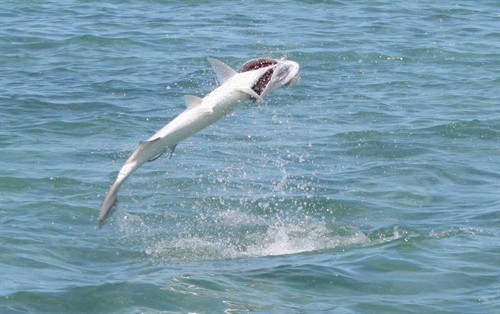About Tarpon
Known for its explosive jumps and raw Power, these fish can raise the pulse of any angler.

In appearance, it is greenish or bluish on top, and silver on
the sides. The large mouth is turned upwards, and the lower jaw
contains an elongated bony plate. The last ray of the dorsal
fin is much longer than the others, reaching nearly to the
tail.
Tarpon are slow growers. They mature at 7 to 13 years of age.
Between May and September the females may lay more than 12 million
eggs. These fish can tolerate a wide range of salinity. They can
breathe air at the surface and feed mainly on fish and large
crustaceans.
Equipment and flies
Flies:
The best pattern could vary, depending on the area, bottom
conditions etc. But it is very important that your flies have good
hooks, sized 1/0 - 4/0
In Isla de la Juventuds channels the black and purple fly have
been a success.
In the area around Cayo Largo we've had success with flies based
on brown/light brown, but we hear that the Black and Purple
"Peanutbutter" by Enrico Puglisi fish good there too.
Rod:
Depending on the size of the Tarpon you fish for, you may chose
an different size of your rod.
Big Tarpon:
Use a good 12 Wt saltwater rod with front grip. The front
grip(fight grip) will be helpful during the fight to add some
extra power fighting big fish.
A rod of this size will be strong enough to help you give the
fish a good fight. A smaller rod will often be to weak, and
you won't be able to add the right preassure during the
fight.
Smaller/Baby Tarpon:
A good 10 Wt rod. This rod will give you a good fight
with smaller tarpons, but will also stand a good fight if you
catch bigger fish.
Reel:
12 Wt reel with enough capacity for your 12 wt line and at
least 150-200 yards of 30 lb backing, and with a strong smooth
drag.
Line/Tip:
12 wt Floating Tropical line in neutral colour, plus a 12
wt intermediate for deeper water.(loop to loop conection for fast
change)
The leader: Maybe the most important part of the Tarpon
fishing equipment
Several quick change Tarpon leaders(standard leader system for
tarpon is the shock leader, an ingenious system spesifically
designed for durability rather than invisibility). The
butt is generally constructed of 30 or 40- pound test mono,
followed by the tippet, or taper, which is made of 12, 16 or 20
pound test. On the terminal end you need a shock tippet of heavy
piece mono 60 - 100 pound test range(about 3 feet long, so you can
use it for several fish, or re-tie at fly changes)
How to catch and land Tarpon
If you are going to catch the Tarpon, you have to present a big
fly a couple of meeters in front of the fish. Move your fly with
long and fast stripps.
When the fish starts to follow your fly its important to stay
cool and continue with your fast stripping. Hopefully you will see
a big mouth opening, sucking in your fly. Wait untill the fish
turns and make two-three hard stripps.
Then make two hard sideways hits with your rod. Your heart wil
jump over a couple of beats when the fish responds. One of the
firste responds from the fish is to jump like a projectile out of
the water, shaking its head to get ridd of the fly.
The fish could easily jump 2-3 meeters up in the air during the
fight. After each jump you have to re-hook your fly by hitting your
rodd hard sideways 1-2 times. Keep on fighting the fish hard, and
lower your rod and your line tight everytime the fish jumps.
If the fish swims towards you, it could be smart to drop your
rod-tip into the water to avoid to much slack on your line to
decrease the chanses for the fly to fall out.
When the fish calms down and you get it closer to the
boat/shore, its important to stay focused untill the guide got hold
of the fish.(normally by gloves or a jaw-claw.
Then remember to take your pic. and release your fish gently
into the water.







